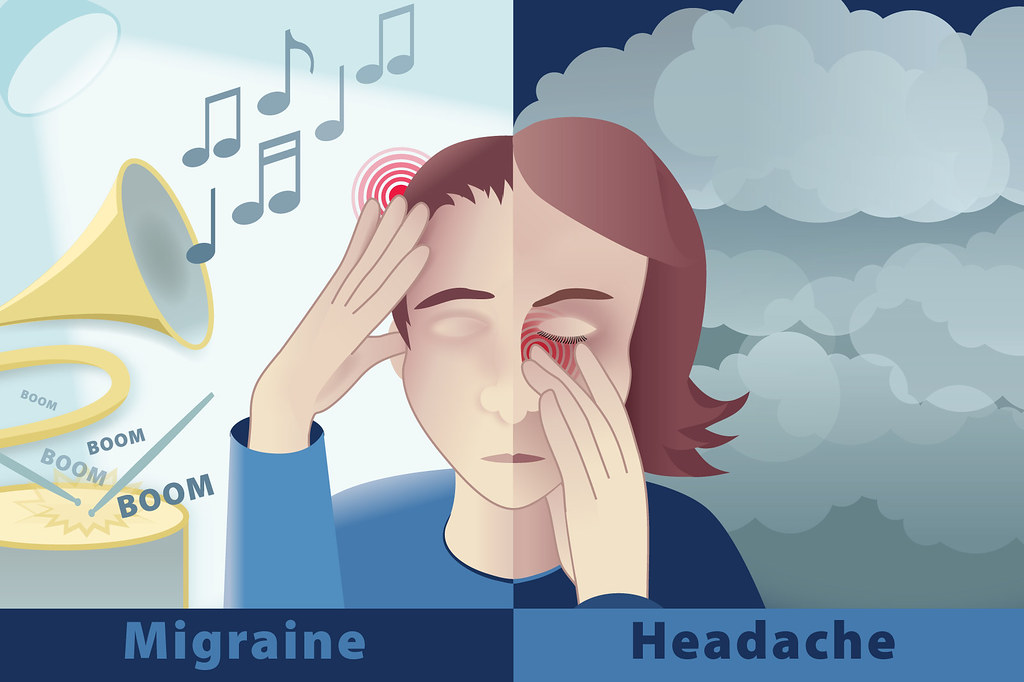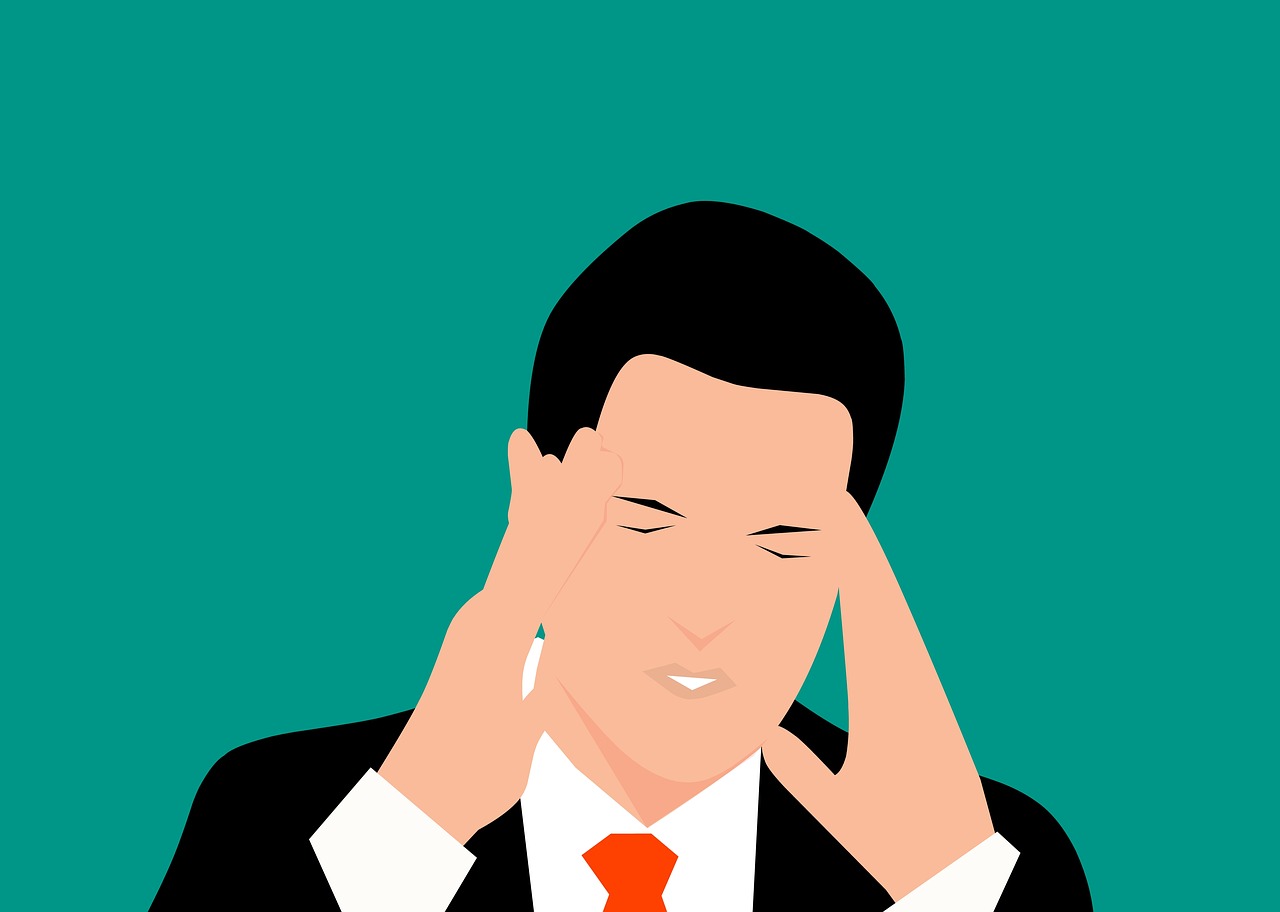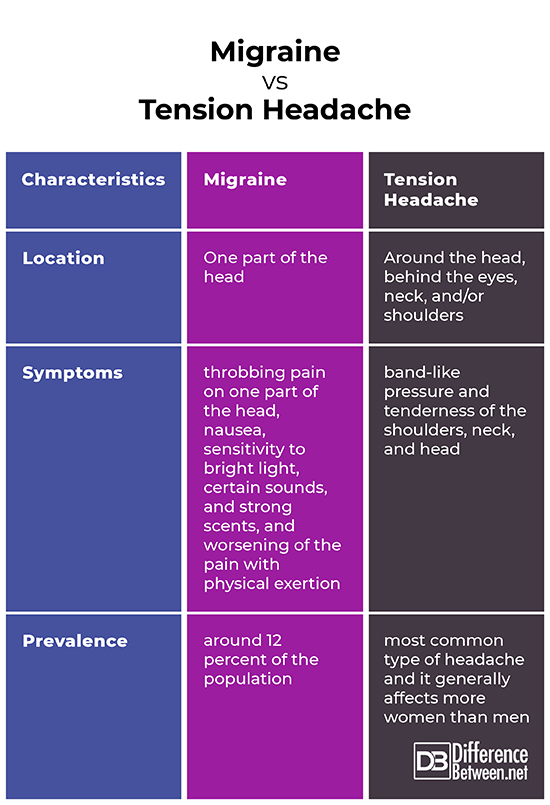Difference Between Migraine and Tension Headache
Migraine and tension headache both involve pain in the head region. They may also have similar triggers such as stress, skipping meals, and poor posture. Moreover, they may be prevented by lifestyle alterations such as having enough rest, exercise, and nutrition. However, migraines are usually localized on one side and are characterized by a throbbing pain while tension headaches are often band-like sensations around the skull or muscle tension in the shoulder and neck regions. The following discussions further look into their distinctions.

What is a Migraine?
Migraines are often felt as severe and recurring headaches which tend to affect individuals aged 15 to 55 years old. The pain, which can last for hours or days, is usually localized one side. An aura of sensory disturbances may precede the headache. While the exact cause is still unknown, it is theorized that it is due to abnormal brain activity and that some are more genetically predisposed to experience migraines. Some of those who have migraines can specify triggers such as hormonal changes (e.g. menstruation), emotional triggers (e.g. stress, excitement, depression, etc.), physical triggers (e.g. low blood sugar level, neck tension, lack of sleep, etc.), diet triggers (e.g. chocolate, dehydration, cheese, etc.), medications (e.g. contraceptive pills, sleeping pills, etc.), and environmental triggers (bright lights, strong scents, smoke, etc.). Migraines may be prevented by lifestyle changes like having sufficient rest and exercise, avoiding certain kinds of food and scents, and reducing stressors. There is currently no cure but there have been advancements on the use of botulin toxin injections and surgery (Webberley, 2017).
According to the American Migraine Foundation (2017), the following are some of the types of migraines:
- Migraine with Aura or Complicated Migraine
A series of sensory alterations (e.g. numbness, seeing dots, etc.) sets in before or during a migraine.
- Migraine without Aura or Common Migraine
Unlike migraine with aura, common migraine lacks the warning phases.
- Migraine without Head Pain, Silent Migraine, or Acephalgic Migraine
Aura, nausea, and other warning phases are experienced but there is no head pain.
- Hemiplegic Migraine
There is a weakness one side of the body but head pain is not always experienced.
- Retinal Migraine
A specific type of aura, which is temporarily losing vision in one eye, accompanies the migraine.
- Chronic Migraine
This is characterized by having a headache for more than 15 days a month.

What is a Tension Headache?
A tension headache is a mild to severe pain which is felt behind the eyes, head, and neck. This most common type of headache generally affects more women than men. Most people who have this condition experience episodic headaches, around once or twice a month. The pain may be described as similar to having a very tight band around the forehead or a muscle tension in the neck and shoulders. Usually, daily activities may still be carried out despite the pain. The symptoms include dull headache, pressure around the forehead, and forehead and scalp tenderness. The triggers include stress, poor posture, lack of sleep, eye strain, sinus infection, flu, alcohol, dehydration, etc. It is caused by the contraction of the muscles in the neck and head. (Higuera & Cherney, 2019). However, other sources say that the specific cause is still unidentified since there now appears to be a more complicated combination of involved factors. Among children, tension headaches may be associated with stressors such as having a new sibling, social isolation, and undergoing examinations. The treatments include pain relievers, stress management, and alternative therapies such as scalp massage, acupuncture, inhaling peppermint or lavender scent, and eating flaxseed. The preventive measures include exercise, healthy diet, and relaxation technics (Taylor, 2019).
According to the American Migraine Foundation (2016), the following are the types of tension-type headaches:
- Infrequent episodic type
Those with this type only experience a few or one monthly episode.
- Frequent episodic type
Individuals with this tension headache experience two to 14 monthly episodes for at least three months.
- Chronic
Those with this tension headache experience more than 15 monthly episodes for at least three months.
Difference between Migraine and Tension Headache
Location
Migraines are generally felt on one side of the head (Webberley, 2017). On the other hand, tension headaches are felt behind the eyes, head, and neck. The pain may be described as similar to having a very tight band around the forehead or a muscle tension in the neck and shoulders ((Higuera & Cherney, 2019).
Symptoms
Migraine is characterized by a throbbing pain on one part of the head, nausea, sensitivity to bright light, certain sounds, and strong scents, and worsening of the pain with physical exertion. In comparison, tension headache is described as a band-like pressure and tenderness of the shoulders, neck, and head (Taylor, 2019).
Prevalence
The American Migraine Association states that around 12 percent of the population experience migraines (Webberley, 2017). In comparison, tension headache is the most common type of headache and it generally affects more women than men (Higuera & Cherney, 2019).
Migraine vs Tension Headache

Summary of Migraine vs Tension Headache
- Migraines and tension headaches both involve pain in the head region, may have similar triggers, and may have similar preventive measures.
- The types of migraines include retinal, complicated, common, hemiplegic, and chronic.
- The types of tension-type headaches are infrequent episodic type, frequent episodic type, and chronic.
- Migraines are generally felt on one side of the head while tension headaches are felt around the head, behind the eyes, neck, and/or shoulders.
- Around 12 percent of the American population experience migraines while tension headache is the most common type of headache.
- Difference Between Hematoma and Melanoma - February 9, 2023
- Difference Between Bruising and Necrosis - February 8, 2023
- Difference Between Brain Hematoma and Brain Hemorrhage - February 8, 2023
Search DifferenceBetween.net :
Leave a Response
References :
[0]American Migraine Foundation. “Tension-Type Headache”. August 8, 2016 https://americanmigrainefoundation.org/resource-library/tension-type-headache/
[1]American Migraine Foundation. “What Type of Headache Do You Have?”. May 9, 2017 https://americanmigrainefoundation.org/resource-library/what-type-of-headache-do-you-have/
[2]Higuera, Valencia and Cherney, Kristeen. “Tension Headaches”. Healthline. September 26, 2019 https://www.healthline.com/health/tension-headache
[3]Taylor, Danette. “Migraine vs. Headache: How to Tell the Difference”. MedicineNet. August 29, 2019 https://www.medicinenet.com/migraine_vs_headache_whats_the_difference/article.htm
[4]Webberley, Helen. “Everything You Need to Know About Migraines”. Medical News Today. November 22, 2017 https://www.medicalnewstoday.com/articles/148373
[5]Image credit: https://pixabay.com/de/illustrations/kopf-schmerz-spannung-mann-3390247/
[6]Image credit: https://live.staticflickr.com/4660/39384098854_1b0c1cbbdf_b.jpg
